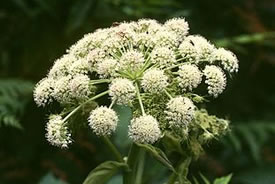
Woodland angelica (Photo by Wikimedia Commons)
Woodland angelica
Woodland angelica may seem quite similar to queen-Anne's lace, but beware: it's actually a member of the celery family and a serious invader of wooded edges and moist open areas in New Brunswick.
How is it identified?
The robust plant has a thick stalk that can grow up to a metre tall, with roots spreading as deep as two and a half metres deep. It features umbrella-like flower heads and leaf sheaths.
Plants can grow more than two metres tall and can commonly found along the side of the road. The plant's sap can cause blisters and rashes when exposed to sunlight.
How does it grow?
This invasive plant spreads through its roots as well as its seeds, and grows quickly. According to the New Brunswick Invasive Species Council, woodland angelica poses a serious threat to native biodiversity across New Brunswick. If left unchecked, it could easily spread across Canada, out-competing other native species.
Where does it grow?
Woodland angelica is native to Europe and Asia. The plants are invading Eastern Canada through Nova Scotia, New Brunswick and Quebec.
What does it threaten?
At the Nature Conservancy of Canada's Shamper Bluff property, volunteers and staff recently gathered with shovels to tackle this invasive species.
How can you help?
Everyone can help to win the battle against alien invasive species. Here are some ways you can help:
- Dispose of yard waste properly. Dumping yard waste in natural areas can introduce alien invasive species that will thrive and spread. Even leaf piles can be problematic, as dumped piles can smother native vegetation. Contact your municipality to find out how to dispose of yard waste properly.
- Plant native species in your garden. There are lots of beautiful native species that attract native butterflies and birds, making your garden twice as beautiful. Native species are also adapted to our climate and often require less rigorous care than exotic species.
- Clean your shoes or bicycle tires when moving between designated trails in different areas. Invasive plants are often spread accidentally from seeds stuck in treads.
- Report any sightings to your local stewardship council.




